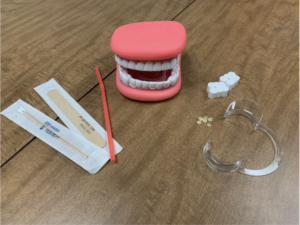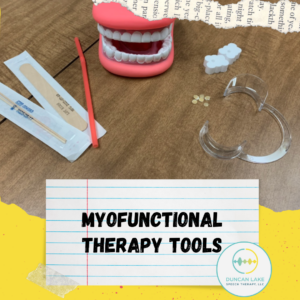by Amanda Redeker, M.A., CCC-SLP
Duncan Lake Speech Therapy, LLC
What is myofunctional therapy?
Myofunctional therapy focuses on establishing appropriate oral, facial, pharyngeal, and mandibular muscle function. This is achieved through use of isotonic (contraction) and isometric (without contraction) exercises. These exercises utilize sensory stimulation and movements that target the muscles of the lips, tongue, jaw, soft palate, and pharynx. The ultimate goal is to improve functions such as breathing, swallowing, and speech. In order to accomplish these goals, SLP’s use a variety of tools to support muscle strength.

What are those tools and why is my therapist using them?
If you wandered into my room at the start of a myofunctional therapy session you might do a double take when looking at the items I have prepared. A straw, a sticky note, a button on a string, bubbles, tiny sticky dots, a tongue depressor, a mirror, a giant mouth model… it may look more like a toddler’s haphazard scavenger hunt than anything else. What could most of these items possibly have to do with myofunctional therapy? Well, good news for you, let the confusion be washed away. Here is a (non-comprehensive) list of 10 common tools your therapist might use and why they use them.
- A straw – a seemingly common household item that can have many uses for myofunctional therapy. Often we use straws to help with lip strengthening and closure.
- A mirror – mirrors are extremely useful for visual feedback. This allows you to see how the muscles around your face and mouth respond to movements.
- Giant mouth model – this is especially useful for small children who are unaware of their tongue/lips/teeth and how they move
- Bubbles – these are used in many sessions for many reasons. Not only are they fun, but the are helpful in illiciting specific mouth postures.
- Small sticky dots – these are made of a special material that allows them to adhere to the roof of the mouth. This allows the therapist to place them in the mouth to aid the client in finding correct tongue placement.
- Bite block – this item is used to help stabilize the jaw when completing exercises in order to isolate the correct muscles and reduce compensatory jaw movements
- Tongue depressor – this is used for a variety of exercises to provide support and/or resistance for the muscles.
- Small elastics (like the ones used for braces) – these can be used to help with correct tongue placement and help the therapist determine if the client has moved placement during an exercise.
- Pencil – this is used for tongue exercises to provide stability and resistance.
- Tape – this can be used to help with lip closure during various exercises.
Resources:
- Shortland, H.-A. L., Hewat, S., Vertigan, A., & Webb, G. (2021). Orofacial myofunctional therapy and myofunctional devices used in speech pathology treatment: A systematic quantitative review of the literature. American Journal of Speech-Language Pathology, 30(1), 301–317. https://doi.org/10.1044/2020_ajslp-20-00245
- Simon Says Speech – Tongue Tip Material List



Recent Comments